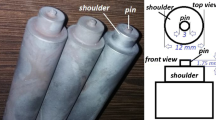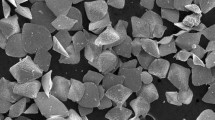Abstract
Possibility of the formation of Al–Al3Ni composite layers on commercial pure aluminium plates by friction stir processing (FSP) has been studied. It is believed that the hot working nature of FSP can effectively promote the exothermic reaction between Al and added Ni powder to produce Al3Ni intermetallic compounds in the aluminium matrix. In this study, the effects of the rotational and traverse speed of the tool as well as the number of FSP passes on the in situ formation of Al3Ni in aluminum matrix were examined. Besides, the microstructure and microhardness of the fabricated surface layers were also studied. The results showed that the ratio of tool rotational speed to traverse speed (ω/υ) is the main controlling parameter of the heat generated during FSP and hence the reaction between aluminium and nickel. Increasing the number of FSP passes also promoted the reaction between Ni and Al and improved the distribution of Al3Ni compounds, too. The composite layer achieved by six passes of FSP showed the highest hardness, which was almost twice of that of the base metal.
Similar content being viewed by others
References
Wang W, Shi Q, Liu P, Li HK, Li T (2009) A novel way to produce bulk SiCp reinforced aluminum metal matrix composites by friction stir processing. Mater Process Technol 209:2099–2103
Hodder KJ, Izadi H, McDonald G, Gerlich P (2012) Fabrication of aluminum–alumina metal matrix composites via cold gas dynamic spraying at low pressure followed by friction stir processing. Mater Sci Eng A 556:114–121
Ma ZY (2008) Friction stir processing technology: a review. Metall Mater Trans A 39:642–658
Mishra RS, Ma ZY (2005) Friction stir welding and processing. Mater Sci Eng R 50:1–78
Mazaheri Y, Karimzadeh F, Enayati MH (2011) A novel technique for development of A356/Al2O3 surface nanocomposite by friction stir processing. Mater Process Technol 211:1614–1619
Mishra RS, Ma ZY, Charit I (2003) Friction stir processing: a novel technique for fabrication of surface composite. Mater Sci Eng A 341:307–310
Dixit M, Newkirk JW, Mishra RS (2007) Properties of friction stir-processed Al 1100–NiTi composite. Scr Mater 56:541–544
Asadi P, Faraji G, Besharati Givi MK (2010) Producing of AZ91/SiC composites by friction sir processing (FSP). Int J Adv Manuf Technol 51:247–260
Huang JC, Chuang CH, Hsieh PJ (2005) Using friction stir processing to fabricate MgAlZn intermetallic alloys. Scripta Mater 53:1455–1460
Hsu CJ, Kao PW, Ho NJ (2005) Ultrafine-grained Al–Al2Cu composite produced in situ by friction stir processing. Scripta Mater 53:341–345
Hsu CJ, Chang CY, Kao PW, Ho NJ, Chang CP (2006) Al–Al3Ti nanocomposites produced in situ by friction stir processing. Acta Mater 54:5241–5249
Lee IS, Kao PW, Ho NJ (2008) Microstructure and mechanical properties of Al–Fe in situ nanocomposite produced by friction stir processing. Intermetallics 16:1104–1108
Chen HL, Doernberg E, Svoboda P, Schmid-Fetzer R (2011) Thermodynamics of the Al3Ni phase and revision of the Al–Ni system. Thermochim Acta 512:189–195
Azizieh M, Kokabi AH, Abachi P (2011) Effect of rotational speed and probe profile on microstructure and hardness of AZ31/Al2O3 nanocomposites fabricated by friction stir processing. Mater Des 32:2034–2041
Barmouz MM, Givi MKB (2011) Fabrication of in situ Cu/SiC composites using multi-pass friction stir processing: Evaluation of microstructural, porosity, mechanical and electrical behavior. Compos Part A : Applies Sci Manuf 42:1445–1453
Gan YX, Solomon D, Reinbolt M (2010) Friction stir processing of particle reinforced composite materials. Materials 3:329–350
Shafiei-Zarghani A, Kashani-Bozorg SF, Zarei-Hanzaki A (2009) Microstructures and mechanical properties of Al/Al2O3 surface nano-composite layer produced by friction stir processing. Mater Sci Eng A 500:84–91
Compton DN, Cornish LA, Witcomb MJ (2001) The effect of microstructure on hardness measurements in aluminium-rich corner of the Al–Ni–Cr system. J Alloy Compd 318:372–378
Author information
Authors and Affiliations
Corresponding author
Rights and permissions
About this article
Cite this article
Shahi, A., Sohi, M.H., Ahmadkhaniha, D. et al. In situ formation of Al–Al3Ni composites on commercially pure aluminium by friction stir processing. Int J Adv Manuf Technol 75, 1331–1337 (2014). https://doi.org/10.1007/s00170-014-6162-3
Received:
Accepted:
Published:
Issue Date:
DOI: https://doi.org/10.1007/s00170-014-6162-3




